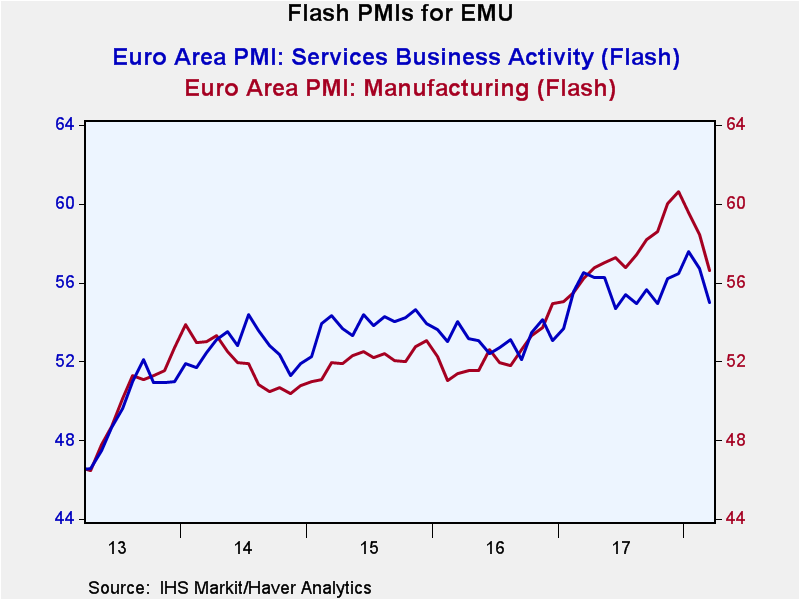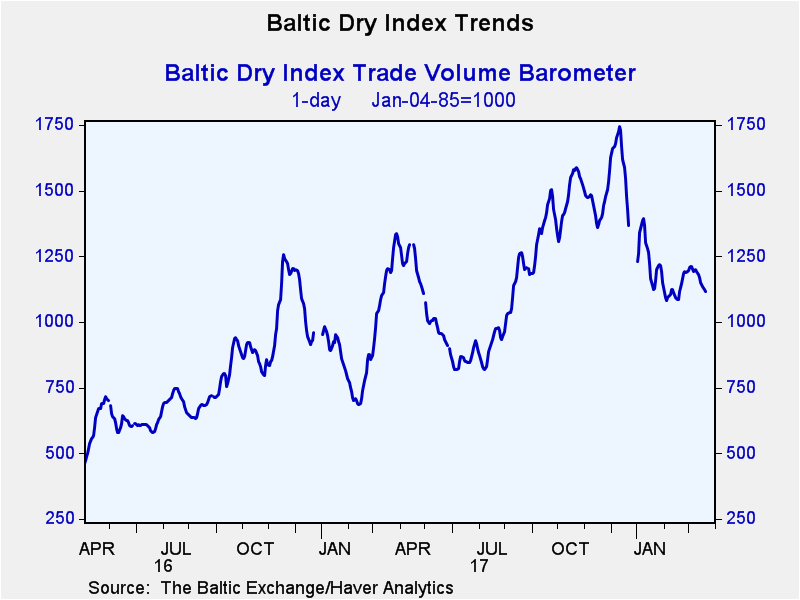 Global| Mar 22 2018
Global| Mar 22 2018Composite PMIs Slip; How Far Will They Slide?
Summary
The drop off in the EMU manufacturing PMI is sharp; two full diffusion points in March. Meanwhile, the services gauge lops off more than one full point. As a result, the overall EMU private sector PMI drops by nearly two diffusion [...]
 The drop off in the EMU manufacturing PMI is sharp; two full diffusion points in March. Meanwhile, the services gauge lops off more than one full point. As a result, the overall EMU private sector PMI drops by nearly two diffusion points and its percentile queue standing fades to a more moderately strong 77.8 percentile with manufacturing at its 81st percentile and services at its 82nd percentile. Not long ago all these metrics were in their (respective) 90th percentiles and high in that 90th decile to boot. Conditions are slowing. That does not mean that they are slow or that the slowing will extend, but there are several metrics now that show that the bloom is off this rose. Will there be a second blooming or must we now deal with the thorns?
The drop off in the EMU manufacturing PMI is sharp; two full diffusion points in March. Meanwhile, the services gauge lops off more than one full point. As a result, the overall EMU private sector PMI drops by nearly two diffusion points and its percentile queue standing fades to a more moderately strong 77.8 percentile with manufacturing at its 81st percentile and services at its 82nd percentile. Not long ago all these metrics were in their (respective) 90th percentiles and high in that 90th decile to boot. Conditions are slowing. That does not mean that they are slow or that the slowing will extend, but there are several metrics now that show that the bloom is off this rose. Will there be a second blooming or must we now deal with the thorns?
Germany follows this same pattern, not surprisingly. As the largest economy in the EMU, it has a large impact on the EMU gauges. The German headline has fallen by more than two points in March with a more than two-point drop in manufacturing diffusion and a more than one point drop in its service gauge. The German manufacturing PMI still retains a strong standing at its 84th percentile. Over the last five-plus years, it has been higher only about 16% of the time. But the weakness and ongoing slippage in the important German services sector is still in train with its queue standing at its 41st percentile and well below its five-plus year median.
France’s private sector PMI falls by a bit more than one point in March and its queue standing is still strong in its 84th queue percentile. France’s manufacturing sector, nonetheless, takes a steep fall of more than two points in March, but the service sector drop off is much less than one full point. As a result, the French manufacturing PMI stands in its lower 80s with an 81st percentile standing with services in their 84th percentile.
Japan’s manufacturing PMI stepped back this month as well as did its (lagging) all-industry index that was released today.
The U.S. private sector gauge eased back on a slightly weaker manufacturing reading and a weaker services reading. The U.S. services sector, like Germany’s, is weak.
Germany also released its closely-followed IFO survey today; that index sits on an 8-month low. The backing off we are seeing in economic assessments is not just an artifact of the PMI gauges. And even before the thump of tariffs is in effect, we have evidence of some slowing in train. Remember slowing first, tariffs second. But I doubt many will remember it this way; it’s the way it is.
 The Baltic Dry Goods index has been in state of decline for some time. It has stabilized at this lower level and it is not yet clear where it will go. The decline in this index is fully in step with the backing off we see in the manufacturing PMI indexes in Europe. It is a barometer of world trade.
The Baltic Dry Goods index has been in state of decline for some time. It has stabilized at this lower level and it is not yet clear where it will go. The decline in this index is fully in step with the backing off we see in the manufacturing PMI indexes in Europe. It is a barometer of world trade.
As we have been pointing out for some time, globally money growth and especially the growth in real money balances have been in a state of deceleration or outright contraction. Rising oil prices may be playing a role here, but nominal money growth has been slowing too. The EMU is an exception of sorts with stable nominal money growth and accelerating nominal credit growth but with weakening trends for real balances. The U.S., the U.K. and Japan show slowdown characteristics.
Instant revisionism
With this ‘new’ economic background, it is good to rethink what just happened yesterday. We are in the middle of what on the data above looks like a slowdown. The Bank of England is preparing for a rate hike perhaps in May. The Fed in the U.S. just raised rates (again) and has laid out a much higher rate profile on speculation that U.S. growth is in the process of accelerating even as the Fed itself launches a weak inflation projection in the face of accelerating growth and ‘way too-low’ unemployment.
The ballpeen hammer strategy
For my money, central banks seem very confused. They clearly are dogged by their own dogma and their mandated bias as inflation fighters- in the EMU they are inflation fighters only, not trained in CPR. The problem here is that there is little evidence that inflation needs any fighting. So in the U.S. attention has been shifted to the ballpeen hammer strategy. You know the one… you hit yourself over the head with a ballpeen hammer because it will feel so good when you stop. That’s right. The Fed at least is set on path of substantial rate hikes that given current leverage and financial fragility that it does not seem to me that the economy is prepared to weather. And why? Because inflation isn’t rising? So the Fed’s fear of a slowdown that rates will not be prepared to deal with (because they are too low) the Fed is raising rates ‘preemptively’ in a way that might actually bring a slowdown into the picture.
Protecting against risk or introducing a new one?
So here we have it. The Fed is in the vanguard of central bank tightening with everyone else on its heels. The Fed is poised for a fiscal kick, but there have been a number of elements of stimulus that just have not panned out for the U.S. as had been expected in this cycle. Here are some of them: Go back to Obama’s in-recession stimulus program, include various Fed actions from cutting rates to zero, to expanding the balance sheet, to twisting the yield curve. Falling oil prices were supposed to fire up consumption. They didn’t. Rising oil prices were supposed help the Fed hit its inflation target in the ‘medium term’ after 2015. They didn’t. Now not only might fiscal policy come up short (with so much of its stimulus aimed at the wealthy), but oil prices are ramping up again on the various geopolitical concerns that have mounted. There are other risks too like tariffs and some potential fallout from trade wars. And yet, in the U.S., ‘forecasts’ from the Fed are la-dee-dahing to more growth lower unemployment and still-low inflation amid more aggressive rate hikes.
If there is one thing I do not think is right, it is the recent set of ‘projections’ from the Fed. I do not know how all this will treat Europe. It has its own messes to distract it from Brexit negotiations to internal discord in Spain to a currently ungovernable Italy. But the Fed’s actions will impact what other central banks do.
The PMI gauges are no longer ‘your friend.’ There is growth, but now there is deceleration. And markets have not yet figured out who is the enemy. The game of handicapping the future is on. Be sure not to just absorb the codswallop from your local central bank. It’s time to look at all the facts and to put on your thinking cap. We are in the midst of strong cross currents. Do not get dragged in the wrong direction here.
Robert Brusca
AuthorMore in Author Profile »Robert A. Brusca is Chief Economist of Fact and Opinion Economics, a consulting firm he founded in Manhattan. He has been an economist on Wall Street for over 25 years. He has visited central banking and large institutional clients in over 30 countries in his career as an economist. Mr. Brusca was a Divisional Research Chief at the Federal Reserve Bank of NY (Chief of the International Financial markets Division), a Fed Watcher at Irving Trust and Chief Economist at Nikko Securities International. He is widely quoted and appears in various media. Mr. Brusca holds an MA and Ph.D. in economics from Michigan State University and a BA in Economics from the University of Michigan. His research pursues his strong interests in non aligned policy economics as well as international economics. FAO Economics’ research targets investors to assist them in making better investment decisions in stocks, bonds and in a variety of international assets. The company does not manage money and has no conflicts in giving economic advice.






